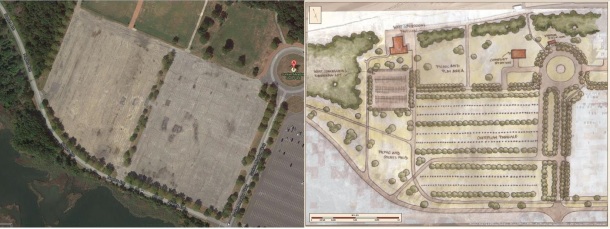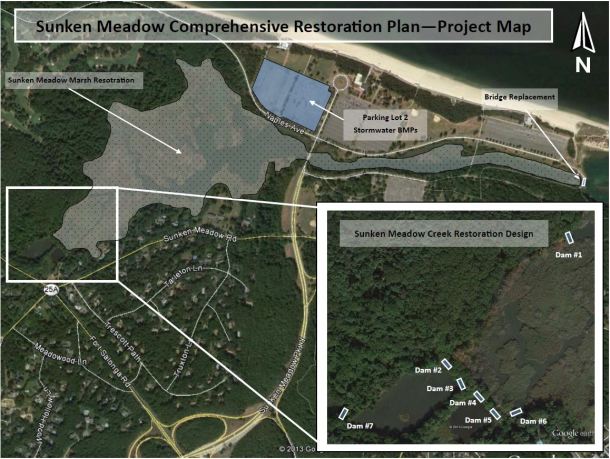Based on CFE/Save the Sound’s successful efforts at Sunken Meadow State Park following Superstorm Sandy (see Part 1 here), we have been awarded a resiliency grant to better protect the park from future severe storms while implementing its Master Plan.
As a leading member of the Sunken Meadow Restoration Team, Save the Sound will begin work on the Resilience & Restoration Plan in the spring of 2015. The upcoming project is our largest yet. We can’t wait to get started. The project has four main goals:
1) Manage stormwater to reduce flooding and improve water quality in Sunken Meadow Creek
Sunken Meadow’s Parking Field #2, a 16.6-acre parking lot used only on the busiest days of the year, is in need of much repair. We plan to replace the cracked asphalt with grass supported by a concrete mesh that will provide support yet allow water to filter through. As a multi-purpose area, the new field can still be used for overflow parking if need be, but mostly Parking Field #2 will become a large grassy space open for recreation, picnicking, and ball fields. It will also allow the nearly four million gallons of stormwater that fall on the pavement annually to naturally seep and filter through the soil, rather than running off and polluting Sunken Meadow Creek. By repurposing Parking Field #2, this project will improve the resiliency of the creek’s watershed, improve water clarity and quality, and help support increasing populations of alewife, eel, waterfowl, and native plants.

2) Strengthen and promote the resilience of the Sunken Meadow marshes
Our project will expand the healthy marsh area by excavating and re-grading more than an acre of low-quality upland area, planting three acres of native smooth cordgrass in nearby mudflats highly susceptible to erosion and invading Phragmities, and enhancing the quality of the 135-acre salt marsh complex. By adding to and improving Sunken Meadow’s marshes, we hope to reduce the threat of erosion and coastal flooding while increasing the area’s use by fish and wildlife. The area has been known as spawning and foraging grounds for bluefish, striped bass, winter flounder, waterfowl, and nesting birds. If we can make these critical habitats better and more accessible, stocks of these species will improve as well.
3) Explore improvements to Sunken Meadow Creek’s riverine habitat
As part of the project, Save the Sound will conduct an analysis and design study to explore potential improvements to Sunken Meadow Creek’s two miles of riverfront habitat. We plan to examine several restoration alternatives with the ultimate goal of making it easier for alewife and American eel to reach the creek from the Sound and coastal marshes.
4) Improve public knowledge and understanding of the ecological communities in Sunken Meadow
Lastly, in partnership with NY Parks, we will engage with the surrounding communities and visiting tourists, and educate them on the natural habitat and wild species they interact with when they come to Sunken Meadow. This high-profile park will provide opportunities for environmental education covering estuaries and tidal wetlands, native versus invasive vegetation, fish and wildlife, green infrastructure and stormwater, and climate change preparedness and coastal resiliency. Our emphasis will be on youth education, and in particular on opening opportunities for young nature lovers to become citizen-scientists. We hope our outreach can help stimulate the general public to greater appreciate conservation and restoration initiatives, and find a lasting respect and responsibility for the wildlands they visit and enjoy.
Posted by Tyler Archer, CFE/Save the Sound


Do you plan to build or eliminate dams. If building? I assume you are planning on adding fish passage
Sorry, Bob, we missed your question!. We’re absolutely not adding any dams. Restoring fish passage around the Sound is a major effort of ours, and we actually removed our first two dams–in New Haven and Mystic, CT–this winter!